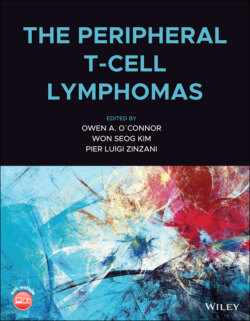Читать книгу The Peripheral T-Cell Lymphomas - Группа авторов - Страница 18
References
Оглавление1 1 Swerdlow, S.H., Campo, E., Harris, N.L. et al. (2017). WHO Classification of Tumours of Haematopoietic and Lymphoid Tissues. Revised 4e. Lyon: IARC.
2 2 Kanhere, A., Hertweck, A., Bhatia, U. et al. (2012). T‐bet and GATA3 orchestrate Th1 and Th2 differentiation through lineage‐specific targeting of distal regulatory elements. Nat Commun 3: 1268.
3 3 Yang, X.O., Pappu, B.P., Nurieva, R. et al. (2008). T helper 17 lineage differentiation is programmed by orphan nuclear receptors RORα and RORγ. Immunity 28 (1): 29–39.
4 4 Plank, M.W., Kaiko, G.E., Maltby, S. et al. (2017). Th22 cells form a distinct Th lineage from Th17 cells in vitro with unique transcriptional properties and Tbet‐dependent Th1 plasticity. J Immunol 198 (5): 2182–2190.
5 5 Malik, S., Sadhu, S., Elesa, S. et al. (2017). Transcription factor Foxo1 is essential for IL‐9 induction in T helper cells. Nat Commun 8 (1): 815.
6 6 Xu, W., Zhao, X., Wang, X. et al. (2019). The transcription factor Tox2 drives T follicular helper cell development via regulating chromatin accessibility. Immunity 51 (5): 826–839.
7 7 Chen, W.J., Jin, W., Hardegen, N. et al. (2003). Conversion of peripheral CD4+CD25− naive T cells to CD4+CD25+ regulatory T cells by TGF‐β induction of transcription factor Foxp3. J Exp Med 198 (12): 1875–1886.
8 8 Tripathi, S.K. and Lahesmaa, R. (2014). Transcriptional and epigenetic regulation of T‐helper lineage specification. Immunol Rev 261 (1): 62–83.
9 9 Vahedi, G., Takahashi, H., Nakayamada, S. et al. (2012). STATs shape the active enhancer landscape of T cell populations. Cell 151 (5): 981–993.
10 10 Klose, C.S.N. and Artis, D. (2016). Innate lymphoid cells as regulators of immunity, inflammation and tissue homeostasis. Nat Immunol 17: 765–774.
11 11 Fousteri, G. and Zhu, J. (2018). T follicular helper‐like cells in inflamed non‐lymphoid tissues. Front Immunol 9: 1707.
12 12 Tripodo, C., Gri, G., and Piccaluga, P.P. (2010). Mast cells and Th17 cells contribute to the lymphoma‐associated pro‐inflammatory microenvironment of angioimmunoblastic T‐cell lymphoma. Am J Pathol 117 (2): 792–802.
13 13 Pepe, G., Di Napoli, A., Cippitelli, C. et al. (2018). Reduced lymphotoxin‐beta production by tumour cells is associated with loss of follicular dendritic cell phenotype and diffuse growth in follicular lymphoma. J Pathol 4 (2): 124–134.
14 14 Bilate, A.M., Bousbaine, D., Mesin, L. et al. (2016). Tissue‐specific emergence of regulatory and intraepithelial T cells from a clonal T cell precursor. Sci Immunol 1 (2): eaaf7471.
15 15 Boutista, J.L., Lio, C.W.J., Lathrop, S.K. et al. (2009). Intraclonal competition limits the fate determination of regulatory T cells in the thymus. Nat Immunol 10: 610–617.
16 16 Szabo, P.A., Levitin, H.M., Miron, M. et al. (2019). Single‐cell transcriptomics of human T cells reveals tissue and activation signatures in health and disease. Nat Commun 10 (1): 4706.
17 17 Miyao, T., Floess, S., Setoguchi, R. et al. (2020). Plasticity of Foxp3+ T cells reflects promiscuous Foxp3 expression in conventional T cells but not reprogramming of regulatory T cells. Immunity 36 (2): 262–275.
18 18 Trüb, M., Barr, T.A., Morrison, V.L. et al. (2017). Heterogeneity of phenotype and function reflects the multistage development of T follicular helper cells. Front Immunol 8: 489.
19 19 Marchingo, J.M., Sinclair, L.V., Howden, A.J.M., and Cantrell, D.A. (2020). Quantitative analysis of how Myc controls T cell proteomes and metabolic pathways during T cell activation. eLife 9: e53725.
20 20 Manso, R., Bellas, C., Martín‐Acosta, P. et al. (2016). C‐MYC is related to GATA3 expression and associated with poor prognosis in nodal peripheral t‐cell lymphomas. Haematologica 101: e336–e338.
21 21 Levayer, R., Hauert, B., and Moreno, E. (2015). Cell mixing induced by myc is required for competitive tissue invasion and destruction. Nature 524: 476–480.
